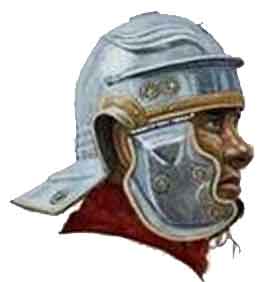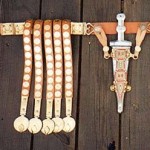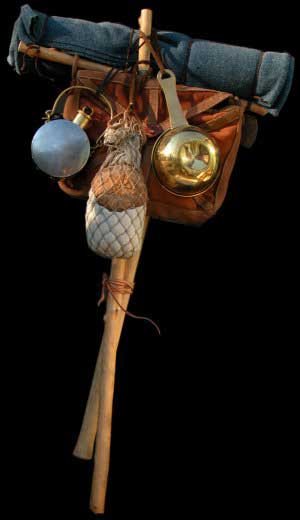Roman Soldier's Gear
The Helmet
 The helmet was designed to protect the solider from sword attack on nearly every part of the head.
The helmet was designed to protect the solider from sword attack on nearly every part of the head.
It had a peak from the brow to defend against a blow to the face, cheek pieces for attacks from the side and horizontal slats at the back of the neck to prevent the opponent's sword from taking off his head. The rear of the neck was vulnerable to upward sweeps that could get between the layers. At the time of Claudius, this was replaced by one with a guard that fitted snugly against the neck.
Armour Cuirass
 This was called the lorica segmentata and consisted of a set of curved horizontal metal strips fastened with hooks and laces at the front and hinged at the back. These were held together by vertical leather strips on the inside. This enabled the soldier to be well protected and also be flexible enough to allow him to bend. The armour was strengthened by front and back plates below the neck. Moving to the shoulders, these were protected by a pair of curved pieces.
This was called the lorica segmentata and consisted of a set of curved horizontal metal strips fastened with hooks and laces at the front and hinged at the back. These were held together by vertical leather strips on the inside. This enabled the soldier to be well protected and also be flexible enough to allow him to bend. The armour was strengthened by front and back plates below the neck. Moving to the shoulders, these were protected by a pair of curved pieces.
The Belt with Apron
 The Cingulum militare was a type of decorated sword belt worn only by the military. Usually these belts were quite ornate and it's thought that the soldiers spent much of their pay on their belt and dagger, as they were perhaps a personal item — almost a status symbol. We don't know if there was a purpose to the studded dangling straps called baltea.
The Cingulum militare was a type of decorated sword belt worn only by the military. Usually these belts were quite ornate and it's thought that the soldiers spent much of their pay on their belt and dagger, as they were perhaps a personal item — almost a status symbol. We don't know if there was a purpose to the studded dangling straps called baltea.
Footwear
 The Roman soldier wore sandals called Caligae (sing: caliga) which were made of several thicknesses of leather and laced up the center of the foot and onto the top of the ankle. The Caligae were studded with conical iron hobnails that were hammered into the sole for added strength. These hobnails were similar to the modern cleat and were for giving good grip and traction when marching over rough ground (along with keeping the caliga from wearing out). It didn't hurt that they also provided good traction when walking over the enemy when he had fallen. Also worn, and more so in the cold climate of Britain, were Calcei. Calcei were an enclosed boot which allowed the feet to be kept somewhat dry and warm.
The Roman soldier wore sandals called Caligae (sing: caliga) which were made of several thicknesses of leather and laced up the center of the foot and onto the top of the ankle. The Caligae were studded with conical iron hobnails that were hammered into the sole for added strength. These hobnails were similar to the modern cleat and were for giving good grip and traction when marching over rough ground (along with keeping the caliga from wearing out). It didn't hurt that they also provided good traction when walking over the enemy when he had fallen. Also worn, and more so in the cold climate of Britain, were Calcei. Calcei were an enclosed boot which allowed the feet to be kept somewhat dry and warm.
Other Gear
We'll lightly touch on the soldier's kit below. Eventually we'll cover it all.
Clothing
- Tunica: a basic garment worn under the armour by all soldiers in the republic and early empire. Normally made of wool. Tunics originally consisted simply of a piece of rectangular cloth sewed to an identical piece, with holes for the arms and head left unsewn. Later, it became fashionable for tunics to be produced with sleeves, and worn with braccae, but saying that, in the early Empire, pants and long sleeves were regarded as effeminate.
- Focale: a scarf worn by legionaries to protect the neck from chafing caused by constant contact with the soldier's armour (typically lorica hamata or lorica segmentata) and helmet
- Braccae: woollen trousers, not full-length, but more calf length.
- Subligaria: underwear — like a loincloth — the existence of Subligaria was confirmed by one of the Vindolanda tablets.
- Cloak: two types of cloaks were used, the sagum and the paenula. Both were made from wool, which insulated and also contained natural oil to repel water. They were fastened with a fibula (a big cloak pin). The paenula was hooded in colder climates. Since every common soldier slept in the open, it was important that he have a warm full-length wrap, but necessary that he carry it with him each day regardless of his activities. This was accomplished by a cloak of more than body length, double-folded so that it did not fall beneath the knees when worn. An excellent illustration of this is the statue of Caesar Augustus atop the theater in the Roman city of Orange, in what is now France.
Sarcina
 The Sarcina was a military pack carried by legionaries and usually included a number of items suspended from a furca or carrying pole. Items carried in the Sarcina included:
The Sarcina was a military pack carried by legionaries and usually included a number of items suspended from a furca or carrying pole. Items carried in the Sarcina included:
- Loculus: a leather satchel attached to the furca pole.
- Waterskin: Roman camps would typically be built near water sources, but each soldier would have to carry his water for the day's march in a waterskin.
- Food: each legionary would carry some of his food. Although a Roman army on the move would typically have a baggage train of mules or similar to carry supplies such as food, after the Marian reforms legionaries were required to carry about 15 days worth of basic food supplies with them.
- Cooking equipment: including the patera (kind of a messkit as we'd know it in modern military sense. The patera was a broad, shallow dish used for drinking, primarily in ritual contexts such as a libation. Also among the cooking gear was a the vas (cook pot) or situla (bucket). Each man had a Poculum (cup) and a Conclear (Spoon)
- Entrenching tools: Carried by legionaries to construct fortifications and dig latrines etc. Each legionary would typically carry either a shovel (batillum) or dolabra (mattock) for digging, a turf cutting tool or a wicker basket for hauling earth.
- Sudis or vale: stakes for surrounding the nightly legion's camp, these stakes acted and were as a kind of primitive "barbed wire," much like modern armies do — to keep the enemy out and from over running the camp.




















